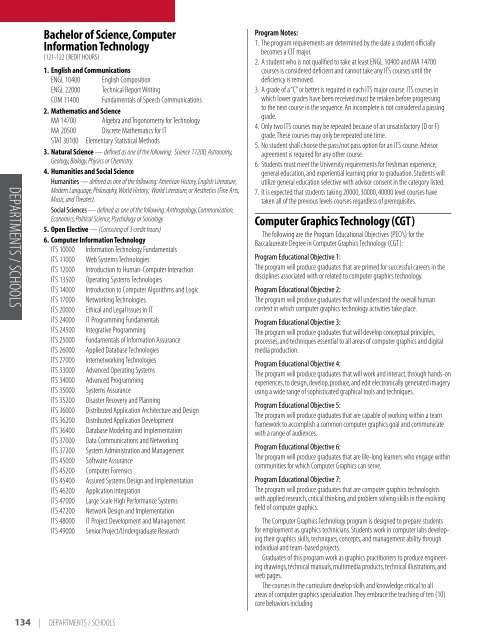Download - Purdue University Calumet
Download - Purdue University Calumet
Download - Purdue University Calumet
Create successful ePaper yourself
Turn your PDF publications into a flip-book with our unique Google optimized e-Paper software.
departments / schools<br />
Bachelor of Science, Computer<br />
Information Technology<br />
(121-122 credit hours)<br />
1. English and Communications<br />
ENGL 10400 English Composition<br />
ENGL 22000 Technical Report Writing<br />
COM 11400 Fundamentals of Speech Communications<br />
2. Mathematics and Science<br />
MA 14700 Algebra and Trigonometry for Technology<br />
MA 20500 Discrete Mathematics for IT<br />
STAT 30100 Elementary Statistical Methods<br />
3. Natural Science — defined as one of the following: Science 11200, Astronomy,<br />
Geology, Biology, Physics or Chemistry.<br />
4. Humanities and Social Science<br />
Humanities — defined as one of the following: American History, English Literature,<br />
Modern Language, Philosophy, World History, World Literature, or Aesthetics (Fine Arts,<br />
Music, and Theater).<br />
Social Sciences — defined as one of the following: Anthropology, Communication,<br />
Economics, Political Science, Psychology or Sociology<br />
5. Open Elective — (Consisting of 3 credit hours)<br />
6. Computer Information Technology<br />
ITS 10000 Information Technology Fundamentals<br />
ITS 11000 Web Systems Technologies<br />
ITS 12000 Introduction to Human-Computer Interaction<br />
ITS 13500 Operating Systems Technologies<br />
ITS 14000 Introduction to Computer Algorithms and Logic<br />
ITS 17000 Networking Technologies<br />
ITS 20000 Ethical and Legal Issues in IT<br />
ITS 24000 IT Programming Fundamentals<br />
ITS 24500 Integrative Programming<br />
ITS 25000 Fundamentals of Information Assurance<br />
ITS 26000 Applied Database Technologies<br />
ITS 27000 Internetworking Technologies<br />
ITS 33000 Advanced Operating Systems<br />
ITS 34000 Advanced Programming<br />
ITS 35000 Systems Assurance<br />
ITS 35200 Disaster Recovery and Planning<br />
ITS 36000 Distributed Application Architecture and Design<br />
ITS 36200 Distributed Application Development<br />
ITS 36400 Database Modeling and Implementation<br />
ITS 37000 Data Communications and Networking<br />
ITS 37200 System Administration and Management<br />
ITS 45000 Software Assurance<br />
ITS 45200 Computer Forensics<br />
ITS 45400 Assured Systems Design and Implementation<br />
ITS 46200 Application Integration<br />
ITS 47000 Large Scale High Performance Systems<br />
ITS 47200 Network Design and Implementation<br />
ITS 48000 IT Project Development and Management<br />
ITS 49000 Senior Project/Undergraduate Research<br />
Program Notes:<br />
1. The program requirements are determined by the date a student officially<br />
becomes a CIT major.<br />
2. A student who is not qualified to take at least ENGL 10400 and MA 14700<br />
courses is considered deficient and cannot take any ITS courses until the<br />
deficiency is removed.<br />
3. A grade of a “C”or better is required in each ITS major course. ITS courses in<br />
which lower grades have been received must be retaken before progressing<br />
to the next course in the sequence. An incomplete is not considered a passing<br />
grade.<br />
4. Only two ITS courses may be repeated because of an unsatisfactory (D or F)<br />
grade. These courses may only be repeated one time.<br />
5. No student shall choose the pass/not pass option for an ITS course. Advisor<br />
agreement is required for any other course.<br />
6. Students must meet the <strong>University</strong> requirements for freshman experience,<br />
general education, and experiential learning prior to graduation. Students will<br />
utilize general education selective with advisor consent in the category listed.<br />
7. It is expected that students taking 20000, 30000, 40000 level courses have<br />
taken all of the previous levels courses regardless of prerequisites.<br />
Computer Graphics Technology (CGT)<br />
The following are the Program Educational Objectives (PEO’s) for the<br />
Baccalaureate Degree in Computer Graphics Technology (CGT):<br />
Program Educational Objective 1:<br />
The program will produce graduates that are primed for successful careers in the<br />
disciplines associated with or related to computer graphics technology.<br />
Program Educational Objective 2:<br />
The program will produce graduates that will understand the overall human<br />
context in which computer graphics technology activities take place.<br />
Program Educational Objective 3:<br />
The program will produce graduates that will developconceptual principles,<br />
processes, and techniques essential to all areas of computer graphics and digital<br />
media production.<br />
Program Educational Objective 4:<br />
The program will produce graduates that will work and interact, through hands-on<br />
experiences, to design, develop, produce, and edit electronically generated imagery<br />
using a wide range of sophisticated graphical tools and techniques.<br />
Program Educational Objective 5:<br />
The program will produce graduates that are capable of working within a team<br />
framework to accomplish a common computer graphics goal and communicate<br />
with a range of audiences.<br />
Program Educational Objective 6:<br />
The program will produce graduates that are life-long learners who engage within<br />
communities for which Computer Graphics can serve.<br />
Program Educational Objective 7:<br />
The program will produce graduates that are computer graphics technologists<br />
with applied research, critical thinking, and problem solving skills in the evolving<br />
field of computer graphics.<br />
The Computer Graphics Technology program is designed to prepare students<br />
for employment as graphics technicians. Students work in computer labs developing<br />
their graphics skills, techniques, concepts, and management ability through<br />
individual and team-based projects.<br />
Graduates of this program work as graphics practitioners to produce engineering<br />
drawings, technical manuals, multimedia products, technical illustrations, and<br />
web pages.<br />
The courses in the curriculum developskills and knowledge critical to all<br />
areas of computer graphics specialization. They embrace the teaching of ten (10)<br />
core behaviors including<br />
134 | departments / schools

















